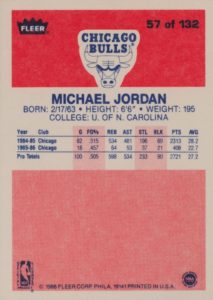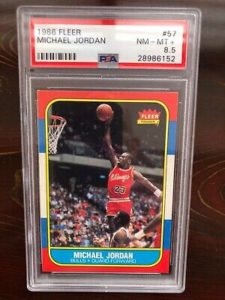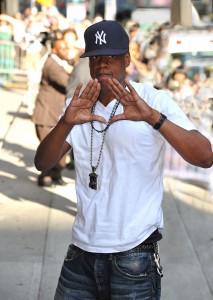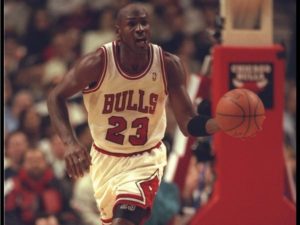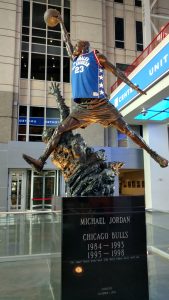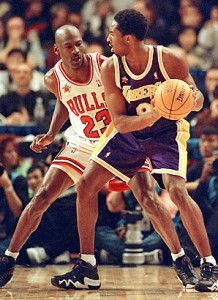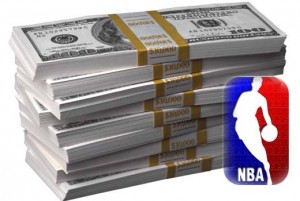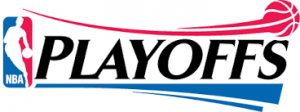Friday sees Michael Jordan, His Airness himself, turn 61. Not only he is widely considered the greatest basketball player of all time, but the debates about who could actually be on his level, a potential rival for the G.O.A.T. status, are actually pretty laughable.
(Lebron James may be the scoring king, surpassing Kareem Abdul-Jabbar, but MJ remains the g.o.a.t.) Additionally, no one, with the possible exception of Phil Knight, has impacted the world of sports wear and athletic shoes, as much as Michael Jordan has.
So it’s no surprise that his most important RC, the 1986-87 Fleer #57 Rookie Card, is the most iconic basketball card in history. And the card is just as relevant today as it was in 1998 when MJ played his final game as a member of the Chicago Bulls.
You can make an argument that the ‘86-‘87 Fleer Michael Jordan is to basketball what the 1952 Topps Mickey Mantle RC is to baseball. With the 1979-80 O-Pee-Chee Wayne Gretzky RC holding this status in hockey.
For football, the G.O.A.T. rookie card is debatable.
When Michael Jordan returned to the Chicago Bulls in 1994 he played in a venue that already had a statue of him outside the gates. This is extremely rare in sports, and it evokes the words of Jay-Z, on Kanye West’s first album, a song entitled “Never Let Me Down.”
Jy-Z took referring to oneself in the third person to new heights (or depths), rapping: “Hov’s a living legend and I’ll tell you why, Everybody wanna be Hov and Hov’s still alive.”
MJ is possibly among the most influential people of all time, on planet earth. Here in Chicago that statue is a major tourist attraction. In other words, His Airness as an individual is a leading tourist site in the nation’s third largest city.
If Michael Jordan’s basketball cards and, in particular, his rookie cards are not a part of your sports card investment portfolio, then get on this. Provided you have the means.
I owned on once, and even though I turned a profit on selling it, I still let it go, and it is one of the biggest financial mistakes of my life.
I bought an ungraded 86-87 Fleer Jordan from a place called Orland Stamps, Coins & Collectibles on Valentine’s Day 1994 for $350 ($691.16 in today’s dollars).
This little shop was in a shopping mall that always struggled to make it, and today is nothing but the anchor stores, and a couple more department stores added around the perimeter of the space. That’s because it’s situated directly across the way from Orland Square Mall, the actual main shopping mall of the area.
Back then though, this mall was alive, and on my birthday (Feb 27) the very next year, I sold it for $500, ($987.37 today) to the other store in that mall were you could buy and sell sports trading cards. It was called The Ol’ Ballpark, and as the name implies, it had a classic baseball stadium theme.
My transaction brought him a 43% return on my investment, as it was a $150 profit.
But also a massive gaffe.
The PSA 10 graded Michael Jordan Fleer rookie card had a mind-blowing 46,000% ROI in 11 months between March of 2019 to January 2021.
Examples like these are what made us look into sports cards as a legitimate form of investing. Please note, in fairness, the 2/11/2021 sale was more or less just off the peak of “Jordan Mania” with the “Last Dance” ESPN film series having taken off just months before.
PSA Authentication and Grading Services, the industry’s leading card grading organization, has called the 1986 Jordan Rookie Card “the most recognizable basketball card and the most important modern card from any sport in the entire hobby.”
Most collectors and even card experts are unaware that Jordan already played two full NBA seasons before the iconic 1986 Fleer card was released.
First, it’s tough to find a truly mint condition, top-tier, flawless card. The borders are notorious for being particularly susceptible to wear and tear, as well as chipping. Mine was ungraded, nor authenticated, these practices were not widespread back then. It was also slightly off-center, and a had a stray dot in the bottom part.
I obviously can’t say for certain what my card would have graded out at, but I’m guessing maybe a PSA 6 or 7. I used to bring it with me, every time I set up shop at card shows, and I placed it squarely in the dead center of my case, even though I had zero intention of selling it (until I did).
Can’t say for certain what I would get on eBay for this, but I’m guessing anywhere from $4,000 to $7,000 probably.
It’s one thing to find a 1986 Fleer Michael Jordan, but it’s quite another to find one with four very sharp and distinct corners. This card was also known for having significant issues with centering.
In 2021, two of them, both graded at the highest level possible, PSA 10, sold at auction for $738,000 apiece. Not bad for a card you might have been able to randomly pull from a pack for 50 cents back in the day. Again this card is anything but rare. It’s from the earlier days of the junk wax era, meaning its from a set that was way over-produced.
But Michael Jordan is Michael Jordan, so his aura defies the basic laws of supply and demand.
His individual accolades include six NBA Finals Most Valuable Player Awards, ten scoring titles (both all-time records), five MVP Awards, ten All-NBA First Team designations, nine All-Defensive First Team honors (joint record), fourteen NBA All-Star Game selections, three All-Star Game MVP Awards, three steals titles, and the 1988 NBA Defensive Player of the Year Award.
Jordan holds the NBA records for career regular season scoring average (30.12 points per game) and career playoff scoring average (33.45 points per game). In 1999, he was named the 20th century’s greatest North American athlete by ESPN, and he placed second only to Babe Ruth in the AP list of athletes of the century.
Michael Jordan was twice inducted into the Naismith Memorial Basketball Hall of Fame, once for his individual career as part of the 1992 United States men’s Olympic basketball team (“The Dream Team”).
He became a member of the FIBA Hall of Fame in 2015. MJ is also known as Mr. June for his unparalleled success in the NBA Finals.
That’s why we’re still talking about him today, and his iconic rookie card.
Paul M. Banks is the Founding Editor of The Sports Bank. He’s also the author of “Transatlantic Passage: How the English Premier League Redefined Soccer in America,” and “No, I Can’t Get You Free Tickets: Lessons Learned From a Life in the Sports Media Industry.”
He currently contributes to Ravens Wire, part of the USA Today SMG’s NFL Wire Network. His past bylines include the New York Daily News, Sports Illustrated, Chicago Tribune and the Washington Times. You can follow him on Twitter.

